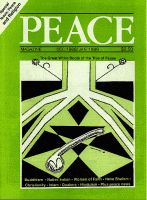
Peace Magazine Dec 1988-Jan 1989, page 6. Some rights reserved.
Search for other articles by Barry Martin here
Native spiritualities are based on a recognition that all natural things are interconnected. The land, Mother Earth, is given primacy. Indians value the community, in contrast to the culture of individualism or private property.
For native peoples in Canada, spiritual and cultural life are unified. During rituals, the Creator is experienced directly. Ceremonies enact the "Life Force." An elder presides over the opening and closing of the ceremonies, usually offering prayers and thanks. Doctrine is passed on verbally by recognized elders, rather than being written down.
Individuals focus on the realization and expression of the inner self, including self-awareness and relationships with others. On "The Good Red Road," one seeks four aspects of enlightenment: strength, knowledge, understanding, and sharing (which translates into love). One strives for self-responsibility and emotional maturity. The metaphor of "combing the snakes out of the hair" is used in reference to the process of dealing with and smoothing out conflicts.
Elders are central to spiritual ceremonies. One elder may have the gift of dream interpretation, another the use of herbal remedies or perhaps healing in a sweat lodge. Elders are the repositories of centuries-old wisdom. Sex is no barrier to being an elder. Sacred objects used by elders in ceremonies are pipes for prayers; tobacco, sweetgrass, sage, and cedar as incense for purification and other functions; and sweat lodges for communal prayer and healing or "doctoring." Fasting, feasting, and spiritual vision quests are other aspects of native spirituality. Often drumming and singing or chanting accompany the various rituals. These are expressions of thanks to the Creator, the Mother Earth, and to the spirits of the various animals and plants and to the other spirit-beings.
Central to native spirituality is the concern for unity, for peace, for a shared understanding among all peoples of the Earth. Paramount also is a respect for world peace and ecological awareness. Just as there were native prophecies foretelling the arrival of the white people, there were also prophecies concerning the seventh generation who would lead the non-Indians back to a concern for peace and for the care of the Earth and all its species.
An early prototype for the United Nations Assembly was the Kaianerenkowa of the Hotinonshonni, or the Great Law of Peace of the Iroquois, or League of Six Nations. The Peacemaker was a Huron who, probably between 1500 and 500 years ago, traveled to Iroquois territory proclaiming the Great Peace. He gradually convinced Hiawatha and Thadodaho of the power of his message. The Peacemaker and Hiawatha journeyed throughout Iroquoia, establishing the League or Confederacy with its fifty sachems or peace chiefs. All the chiefs of the council agreed to "roll their words into one bundle" and be of "one heart, one mind, one law." The League was established to create and maintain peace among the Six Nations and among any other nations with whom they came into contact.
The Peacemaker and the Iroquois knew that peace would endure only so long as people recognize the sovereignty of a common law. For the Six Nations, the peace incentive was complex and rooted in three aspects: the example of two culture heroes (The Peacemaker and Hiawatha), a unique interpretation of the meaning of peace itself, and a set of peace symbols that fired the imagination. "The power of law... brought these nations into a union cemented by such powerful sanctions of law, custom, and religion as served to make it all but indestructible." Peace was the law, the same word expressing both concepts. Peace was righteousness in action, the practice of justice among all individuals and nations. "Peace was a way of life, characterized by wisdom and graciousness."
The powerful symbol for the Great Peace and the League was the Tree of Peace, a tall White Pine Tree. In contemporary artistic representations, it still has the watchful Eagle perched atop, guarding the peace and the people, the Four Great Roots reaching deep into the Earth Mother, and to the Four Directions, and the war clubs of battle buried beneath the Tree. The Tree symbolized the Law and their constitution; the Branches symbolized shelter, security, and protection for the people; the Roots embraced all nations of the earth and brought them under the Peace and the Law.
It has been at least five centuries since the founders of the League met to establish the Great Peace. The League still survives today. The Grand Council of the Confederacy meets at both Onondaga, New York, and Ohsweken, Ontario. Though they have suffered many defeats, the Law is still a guiding force and the people have persisted.
A contemporary Mohawk greeting is skennkowa ken? -"Are you at great peace?". A motto for the national native organization, the Assembly of First Nations, is "one mind' one heart, one spirit." Spiritually and politically, the native peoples are rising again. Perhaps the world will listen this time.
Barry Martin, PhD., teaches at U. of Toronto, Ontario College of Art, and practices psychotherapy.

Peace Magazine Dec 1988-Jan 1989, page 6. Some rights reserved.
Search for other articles by Barry Martin here